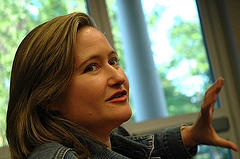
There is an impulse when we see quirky videos we like on YouTube to email them on to friends or co-workers. When those catchy videos start accumulating viewers, marketers say it’s gone viral through word-of-mouth popularity. So what if you could take videos shot by citizens of human rights violations, such as police brutality or torture, and got them to go viral, bringing more attention to the crimes?
That’s the hope of a pilot Human Rights Video Hub run as a joint venture of Witness and the Global Voices international blog aggregator.
The two non-profit groups have the perfect experience to make such a project work. Witness was co-founded by musician and activist Peter Gabriel in 1992, and has enabled people to videotape and publicize human rights abuses worldwide. And Global Voices has become a respected outlet in the blogosphere for its editors based around the world who aggregate and explain issues that bloggers are writing about in various countries. The site recently won the Grand Prize in the Knight-Batten Awards for Innovation in Journalism.
While Witness was founded right after the infamous video of Rodney King being beaten by police, it’s only now that Gabriel’s vision for the non-profit can be realized with so many citizens having videocameras and videophones — and the global platform of the Internet to promote them. Gillian Caldwell (pictured here), the executive director of Witness, told me they had high hopes for the Video Hub helping to make the tools of video advocacy available to anyone in the world.
“[Gabriel’s] initial concept for Witness involved the establishment of a populist media-creation platform,” she said via email. “He wanted to put video cameras into the hands of as many human rights activists as possible in the hope that they would capture evidence of abuses and put their footage into the public sphere, provoking global response. Peter knew that moving images communicate with an immediacy matched by no other medium, and they inspire people to take action. Today, with the emerging possibilities of media creation and distribution demanding our fresh attention, it’s time to take the next step in Witness’ evolution.”
The Video Hub pilot just launched a couple weeks ago, and has two fascinating blog posts so far. One post explains how people are using cell phones to show police misconduct in Malaysia, while the other showcases a video of Chinese police beating people after a protest surrounding the possible murder of a young teacher in Ruian.

In both cases, Video Hub editor Sameer Padania (pictured here), who’s based in London, worked with Global Voices editors to help shape a deeper exploration of the issues surrounding the videos, which were both posted on YouTube. In fact, the Video Hub during its pilot phase will host no videos, instead relying on public video-sharing sites to do the hosting, and simply embedding the videos in Global Voices blog posts.
Giving Videos More Exposure
Rebecca MacKinnon (pictured below), a co-founder of Global Voices and former CNN correspondent in Asia, told me she is planning to move to Hong Kong in January to teach journalism at Hong Kong University. MacKinnon will continue to work on Global Voices, and will help oversee the Video Hub project. She told me Witness.org was paying Padania a part-time salary and that Global Voices would help publicize the content using word-of-mouth in the blogosphere. Plus, Global Voices managing editor Rachel Rawlins would check each post to make sure the content is appropriate and fits with the site’s overall mission.

“We have a certain approach to what gets posted and how things need to be posted so they get traction in the blogosphere,” MacKinnon said. “So we’re working with [Padania] so before his posts get published that he’s linking to [relevant content] that’s out there. He’s working with various regional editors who follow blogs in their region…For example, with the China post, he got a lot of help from our Chinese language editor John Kennedy who translates things out of the Chinese blogosphere. [Padania] coordinates with them, and our managing editor gets a final sign-off to make sure it’s appropriate for Global Voices and checks for grammatical errors and so forth.”
So far, the story on China has picked up the most traction online, with a post on China Daily News and on BBC’s Newsnight blog.
But one advisor on the Human Rights Video Hub project, Rik Panganiban, notes on his blog that there are issues with having people commenting publicly on the videos at YouTube:
You can already see on the YouTube page of the Malaysian video some potentially offensive and even re-victimizing messages emerging from the open comments feature that many online video hosting sites support. What is the useful purpose served for someone to risk beating, imprisonment and even death to film a human rights violation and then have random surfers post comments like “ur filming sux like shit!” and “ u had such a good chance…what a waste…sigh…your hand shaking or what??”
Even worse, you could have a debate rage in the comments section between government apologists and protestors, or between different factions on a particular political issue. At what point will this create more heat than light? This is perhaps an acceptable risk. A few hurtful words is still better than imprisonment or a beating. Still, people posting content on sites like You Tube need to be prepared for the potential backlash.
On that particular video, there’s even a comment on YouTube from someone named ggk21 who claims to have been at the scene and thinks the police had cause to fire shots in the air as the people there “really provoke police with threat.” That comment could plant seeds of doubt as to what the circumstances were surrounding the police’s conduct. Perhaps Padania will have to return to these videos and check out future leads as to what happened and debunk public comments when necessary.
For now, MacKinnon hopes that Global Voices can help give context to the range of videos you can find on YouTube, and help separate the wheat from chaff.
“We’re not creating a human rights YouTube thing,” she said. “That has a very tough set of issues, bandwidth and hosting costs of course. It’s very difficult to control an open system where anyone can upload video. You can get a lot of things that you wouldn’t want to be vouching for, and wouldn’t necessarily be human rights issues…If you go into YouTube on your own, you’ll find all kinds of things, but it’s hard to find anything in particular and you don’t have context about what you’re seeing. That’s what we’re trying to do with [the Video Hub], providing that curating function and providing context. The point here is giving people a platform to have their messages amplified.”
Witness’ Grand Plans
MacKinnon says the current Video Hub is an experiment, and that Global Voices will use the lessons learned to incorporate citizen-generated video reports — not necessarily related to human rights — into future projects, not as yet planned. The Video Hub’s editor, Sameer Padania, eventually would like to see people notify him of videos they’ve posted.
“At the moment, we’re still sizing up the territory with regard to the kinds of videos we are finding,” Padania told me via email. “At this early stage it’s unlikely we would come across wholly original footage that no one else had seen, but as we go along, and more people get to know about the site, that becomes more possible. At this stage, we’re unlikely to be dealing with a video where we would need to assist the person(s) involved directly. The planned full-scale Video Hub is more likely to face those sorts of issues, and over the course of the pilot, we’ll be modeling how we would need to act.”

The Video Hub producer from Witness, Tina Gongsakdi (pictured here), told me her group takes very seriously the issues of safety for the videographer and for all the people involved in these troubling situations.
“Recently we have seen many examples of sites that have had to hand over user information to certain government organizations,” she told me via email. “Internet users often overestimate the security of their personal information — if the information is out there, ultimately it can be traced to you. As part of our support to users, we are providing guidance on anonymity [and security]=, and also an extensive chapter in our ‘Video for Change’ training book on how to assess risk in filming, and ensure informed consent. However, we recognize that in an online context we do not have the capacity to provide comprehensive protection to individuals who post, and we are trying to make this clear to potential users.”
Despite all the risks, Witness still has plans to take the Video Hub to the next level after a three-to-six month pilot phase and accept videos directly to its site. The group’s executive director Gillian Caldwell envisions a site that will become “the global online destination” for video content related to human rights violations, and provide tools and resources for activists and journalists to take action and become engaged in the issues.
“The Video Hub will be a forum for online communities and individuals to organize around video and create positive change,” Caldwell said. “Imagine a ‘Darfur genocide’ user group, featuring daily uploads from mobile devices from four anonymous humanitarian aid workers of ongoing brutality, with coordinated email blasts including embedded links to the video targeting a U.S. Congressional subcommittee considering appropriations for an increase in security forces.”
Caldwell foresees a video site that will have three tiers of filtering: 1) Video Hub staff will review videos for inappropriate material such as copyright infringements or pornography; 2) users will rate videos for production quality, urgency and importance, and can flag inappropriate material; 3) editors and selected members of the human rights community will spotlight select videos that have been fact-checked to verify what happened.
It’s a nice plan, and the potential is obvious for creating such a video hub that allows submissions from the public and includes editorial vetting and context, such as what Global Voices is helping with today. But there are certainly tough issues surrounding such a future hub that is more open to submissions. As advisor Panganiban spells out on his blog:
There are a number of thorny questions to address in transforming Witness’ work into an Internet environment, including a number of difficult security, content management and community development challenges. How do you protect the identities of people who upload video content to the site? How do you manage the potentially thousands of videos that could be sent to the site? Should people be allowed to comment on and rate the videos? How to deal with graphic violence and sexual content?…
It seems self-evident that Witness.org staff are never going to be in a position to process, review, contextualize and translate video content on human rights situations coming in from around the world. So their goal should be to focus on discrete issue areas — such as child soldiers — and regions — like Southeast Asia — and then seek out local partners to work with them to manage the video content. In this way, they can slowly see what works and what doesn’t, and learn how to incorporate wider and wider communities of activists, translators, bloggers, techies and human rights experts.
What do you think? Do you like what you’ve seen of the pilot Video Hub, and what are your concerns or hopes for a more expanded hub in the future? Share your thoughts in the comments below.
[Photo of Rebecca MacKinnon by JD Lasica.]

Hardly coming out like gangbusters, unfortunately. A handful of poorly shot videos may be a lot better than nothing but jeez do I wish the left would crank it up a notch. Somebody pay the editor a full time salary for one thing. For gawdsake there’s so much money being thrown around to get commercial interests up to speed around YouTube alone. Ugh.
Sameer (our video editor) will be posting soon on the dirth of compelling human rights-related video online at the moment. That dirth is part of the motivation for the forthcoming hub we are planning- we hope that generating a vibrant space online where human rights related content can be found and acted on – will motivate more people to upload content of what’s going on all around them. For now, its fairly slim pickings for all the reasons Mark suggested in his post. As for paying Sameer a full-time salary — we’re ready and willing, Marshall….once we have the funds. Care to contribute? :)
Hi Mark. Thanks for the quotes from my blog.
I can relate to Marshall’s impatience to “crank it up a notch.” But I think, as you’ve noted, there are enough potential landmines along the way, that it makes sense for WITNESS to go slow and carefully.
I’m sure they wish they could pay a full-time video editor. Sadly, this is a growth business, not in the profits department, only in the violations.
Read the last and excellent article of Video Hub editor Sameer PadaniaTunisia: Opening prisons to the world, about the use of video in a fabulous mushup Tunisian Prisoners Map of blogger and activist Sami Ben Gharbia
Whatever the result of this experiment, it will be tremendously useful to all of us who want to know how open platforms can act as zones of public media. Both WITNESS and Global Voices have notably been courageous in trying new things and learning publicly from what doesn’t work. The field is certainly open, and it seems clear that public broadcasters aren’t going to be experimenters so much as, at best “fast followers” (I got that from Mitch Kapor, who told pubcasters at WGBH a couple of weeks ago that that was their best hope).
Mark,
a quick update… The GV/WITNESS Human Rights Video Hub Pilot won in the New Media category at the One World Media Awards in London last week.
More info after the jump:
http://www.owbt.org/pages/awards/awards2007/awards2007_ceremony.html
Regards,
Sameer
AidLink
July 2007
The Monthly Newsletter of The Aidmatrix Foundation
In This Issue
U.S. Chamber Highlights Aidmatrix Solution in Disaster Exercise
Supply Chain Industry Group honors Aidmatrix
Aidmatrix and Free Clinics Help Uninsured Texans
Quick Links
The Governor’s Blog
About Us
Donate
Network Featured in Earthquake Simulation
The Business Civic Leadership Center (BCLC), the philanthropic voice for the U.S. Chamber of Commerce, hosted an open summit for business leaders in conjunction with the Disaster Assistance and Recovery program. One of three business-designated programs offered by the BCLC, this event focused on a disaster simulation for States in the New Madrid Fault Zone. The land area encompasses several states and has been site of the four largest North American earthquakes recorded. Our organization was a featured presenter, sharing the many solutions the Aidmatrix Network can provide during this type of disaster, including assistance to businesses in getting the Right Aid to the Right People at the Right Time. The forum outlined ways businesses can communicate, coordinate and collaborate with each other (and those in the nonprofit and government sectors) for meaningful support in issues surrounding disasters.
.
Supply Chain Professionals select Aidmatrix as Award Finalist
The Council of Supply Chain Management Professionals has announced Aidmatrix is one of seven finalists for the 2007 Innovation Award for industry leaders. Winners will be determined in October. “Many of these other finalists partner with Aidmatrix, helping us improve humanitarian aid,” said Aidmatrix President and CEO Scott McCallum. “We look forward to joining them and sharing how we use supply chain technology to connect those who have with those who have not.” Past finalists and winners include: Hewlett-Packard, IBM, Kellogg, Procter & Gamble, Dow Chemical, Kraft and Blockbuster.
Helping More People when People Hurt Most — Uninsured Texans benefit from Health Care Aid
The Meadows Foundation empowered Aidmatrix with funding to improve health conditions in the state of Texas. In partnership with the National Association of Free Clinics, Aidmatrix has orchestrated aid of medicines and supplies valued at $12 million to some of the more than 200 clinic affiliates in Texas. The on-line product management solution, FreeClinicLink, connects vital equipment, supplies and medication for use to clinics that strive to serve the population of more than 45 million uninsured Americans. The grant allows five temporary staff for outreach to clinics to connect them with the technology. In less than six weeks the staff has visited close to 20 percent of the affiliate clinics; and integrated and trained 10 percent. The second phase of FreeClinicLink has processed a donation of Ribavirin (an anti-viral medication used to treat hepatitis C) available to all the clinics. Medical companies offering products include Invacare Supply Group, Legacy Medical International and Henry Schein, along with Triple I and AmeriCares.
You can view on this link http://www.responsenet.org/show.detail.asp?id=3132